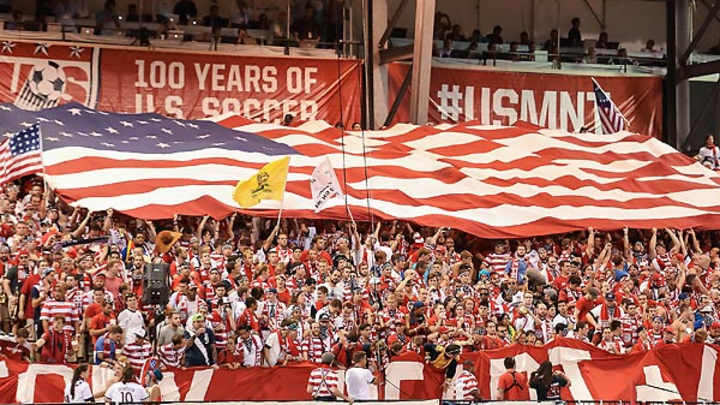American Outlaws' growth highlights distinct passion among U.S. soccer faithful

The American Outlaws now have 100 chapters, even in non-traditional soccer markets. (Jamie Sabau/Getty Images)

My first genuine exposure to soccer beyond U.S. borders came in the spring of 1998. The World Cup was a few weeks away.
Thanks to my friendship with Paul Woolfson, the former head of London’s Sheffield Wednesday supporters club, I spent a couple of weeks living the life of a genuine English football fan. From the train ride to Hillsborough to the pick-up games and snooker matches against rival supporters groups, I enjoyed a brief but unforgettable immersion in that fascinating culture.
Along the way, there was one particular conversation that stood out. It occurred at a pub, naturally, and it concerned the primacy of club over country. Among the London Owls, there was consensus – they’d rather see Wednesday win the Premier League than England lift the World Cup. I was stunned but was assured the sentiment was typical.
The passion U.S. fans feel for their national team isn’t unique. But it is different. Patriotism is a big part of it. That phenomenon is evident during the Olympics, when millions of Americans suddenly care deeply about sports that barely register before and after the Games. And it’s obvious during the World Cup, the one month every four years when soccer is mainstream in the U.S.
The national team's popularity also reflects soccer’s awkward growth here. For the generation that served as the sport’s American vanguard -- the kids who pulled soccer from its niche when they took to suburban fields in the ‘70s and early ‘80s and who now wield such significant influence -- there wasn’t much to look up to. The NASL was flimsy and dying and a league like MLS was a fantasy.
But there was a U.S. national team. It was the country’s club. The Americans who tied Argentina at the 1988 Olympics and then played in the 1990 and 1994 World Cups were common heroes among the legions who now play, coach and support the game. The London Owls were raised on Sheffield Wednesday. A generation of American fans was raised on a diet of red, white and blue.
Two of the younger members of that pre-MLS cohort, Justin Brunken and Korey Donahoo, put their passion to work. What started in 2007 as a small group of fans in Lincoln, Neb. gathering at a bar to watch the U.S. or arranging the occasional road trip has blossomed into a nationwide network of supporters numbering more than 15,000.
The American Outlaws now boast 100 chapters, many of which are in places like Sioux Falls, S.D. and Jackson, Miss. that seem far removed from the soccer spotlight. The sport has spread, and the organization’s influence now shapes the way national team matches are staged, presented, and covered.
The U.S. Soccer Federation reserves sections for organized supporters (there were around 9,000 seats set aside for last month’s U.S.-Mexico match in Columbus). They’re given leeway to coordinate chants and elaborate displays. The parties and pep rallies that accompanied this year’s World Cup qualifiers, which became multi-day events for the first time, are a reflection of the increasing enthusiasm. No story about a U.S. game is complete without a photo or reference to the AO spectacle, and even the group’s internal politics have been covered by major websites.
AO quickly has become a colorful and integral part of American soccer culture, one with a gravitas that likely will appeal to the next generation of fans. The London Owls certainly would appreciate that.
In July, in part because I thought they were cool and in part to make a point about branding in general, I compiled and posted around 50 AO chapter logos on Twitter. I was impressed with the creativity, spirit and artistry behind them. I also wanted U.S. clubs to see that fans, when left to design their own symbols, were inspired by local and civic imagery – not generic shields or random snarling animals or traditions stolen from teams across an ocean.
Continue to Page 2 with 90 American Outlaws chapter logos
STRAUS: Emotional end to CONCACAF World cup qualifying in images, videos and words
The AO banner has become a constant at U.S. national team games around the country. (Cal Sport Media via AP Images)

After attending the recent qualifier in Kansas City, where AO inducted its 100th chapter (Wichita), SI’s Grant Wahl suggested that we publish some of the chapter crests in the magazine. Senior Editor Adam Duerson made the space in the Oct. 21 issue and thought posting the remainder at Planet Fútbol would be a good idea. So, here they are.
We did our best to find clear, current logos for as many chapters as possible. We located most, but not all. The American Outlaws script was cropped from some so the original, local portion would be easier to appreciate. There are common elements in many – that script, AO bandana or crossbones – that tie the chapters together. But fierce hometown pride also emerges, creating a sense of club AND country -- not “or”.
If American soccer’s delayed emergence leaves a positive legacy, it very well may be reflected in the logos below.









WAHL: Three thoughts on U.S.' come-from-behind win and crazy night in CONCACAF
